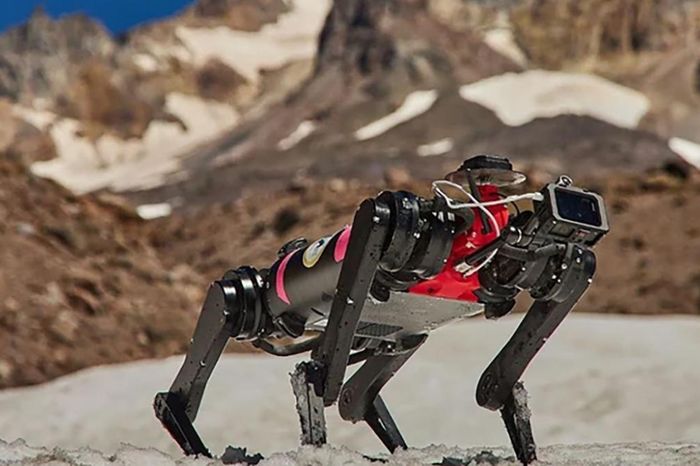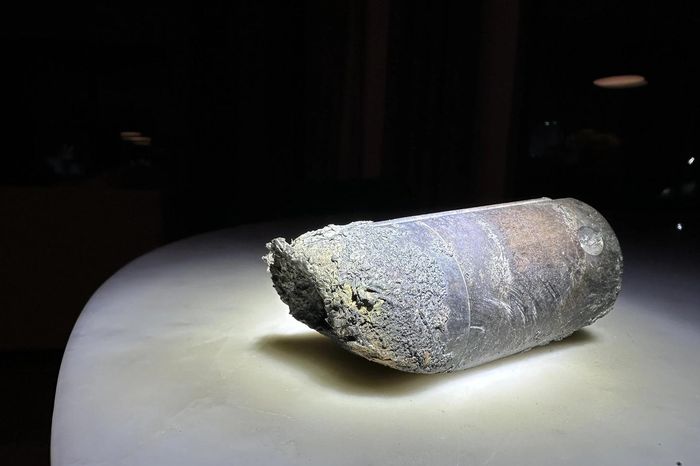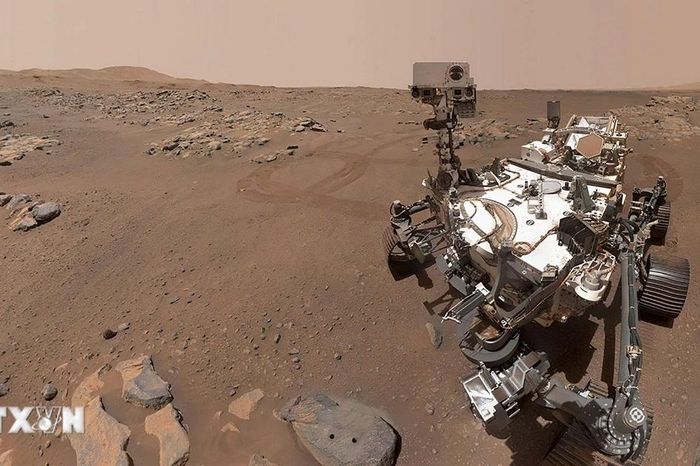'Sudden death', the alien hunting ship still had time to leave behind its treasure
Ingenuity is one of two warriors on NASA's Mars 2020 mission, which left Earth in mid-2020 on a mission to search for evidence of alien life on Mars - ancient or alive.
Unfortunately, a few months ago Ingenuity - a helicopter-like robot - fell and broke its rotor. It said goodbye to humanity and NASA announced the end of its mission on January 25.
However, NASA just revealed that this durable robot is not really dead.

According to the latest announcement, NASA said their small robot continues to use its remaining energy to collect data from the place where it crashed and transmit it to Earth.
On April 16, NASA officially received the final data package from this warrior.
However, Ingenuity is still not sleeping peacefully. It is trying to take advantage of the remaining power to collect another set of data about the land that NASA believes contains evidence of alien creatures, and where it crashed and remained forever.
However, to retrieve the final gift that Ingenuity left behind for humanity, NASA will have to launch another mission to Mars, using another robotic ship or sending a crew, to reach Ingenuity directly.
Ingenuity is a companion of another famous alien hunting robot, Perseverance.
Ingenuity's mission is to scout from above, get preliminary data to help orient its friend - a slower, heavier, autonomous vehicle-like robot with many tools - to continue collecting in-depth data. .
During the Mars 2020 mission, scientists expect Ingenuity to operate for 30 days and conduct five test flights around the site where it and its companion landed.
However, the couple has tirelessly accompanied them for nearly 3 years, since landing in June 2021. When Ingenuity crashed, Perseverance went looking for it, but unfortunately the helicopter had a broken wing and one wing was damaged so it could no longer fly.
Perseverance is still running well so it will continue to explore the Jezero Crater area, a 45 km diameter impact crater containing both a river delta and a large lake, where NASA believes life once, or still resides. treat.
NASA's autonomous rover robot is very durable. Perseverance's predecessor Curiosity is still operating in Gale Crater, another "life zone" about 2,300 km from Jezero Crater. Curiosity was launched in 2011.
You should read it
- Here's your chance to design a NASA payload for a Roomba-sized moon rover
- NASA opens the entire library of photos, videos and audio for free, anyone can see
- NASA will prioritize the recruitment of experienced scientists in blockchain and cryptocurrency
- NASA's top secret inventions have just been revealed
- NASA launches new Sun tracking tool
- Did NASA ships indirectly bombard other planets?
- Why didn't NASA intend to return to the Moon?
- How to watch NASA and Russia launch a new crew to the ISS on Thursday
May be interested
- Treasure of Roman coins found in the old cemetery in Gelderland
 a warehouse of coins from the last days of the roman empire was found in an orchard in gelderland. experts believe that this treasure was buried by an army leader frankish in the second half of the v century, when the area was part of the western roman empire, collapsing in 476 ad.
a warehouse of coins from the last days of the roman empire was found in an orchard in gelderland. experts believe that this treasure was buried by an army leader frankish in the second half of the v century, when the area was part of the western roman empire, collapsing in 476 ad. - Learn about the game Snake Hunting that is causing a fever today
 snake hunting game is a low-configuration game with simple graphics but has attracted a large number of players after only a short time of launch.
snake hunting game is a low-configuration game with simple graphics but has attracted a large number of players after only a short time of launch. - The project to search for alien life stopped working after 20 years
 after 20 years of trying to find alien life, the seti @ home project has officially set the time to stop operating.
after 20 years of trying to find alien life, the seti @ home project has officially set the time to stop operating. - Things you should not leave in your car
 cars are a means of transport with a large storage capacity. however, you should not leave the following items in the car.
cars are a means of transport with a large storage capacity. however, you should not leave the following items in the car. - Cheetah hunting newspaper sped up 0-95km / h in 3 seconds to defeat the spectacular prey
 this african jaguar is said to be a lightning bolt that is the most powerful predator on the steppe thanks to its ability to accelerate from 0 to 95 km / h in just 3 short seconds and reach its maximum speed within 60 seconds.
this african jaguar is said to be a lightning bolt that is the most powerful predator on the steppe thanks to its ability to accelerate from 0 to 95 km / h in just 3 short seconds and reach its maximum speed within 60 seconds. - 10 interesting facts about the legendary Titanic little known
 although it has been submerged in the ocean for more than 100 years, the legendary titanic still contains many mysteries.
although it has been submerged in the ocean for more than 100 years, the legendary titanic still contains many mysteries. - Is the 'alien skeleton' found in Peru true?
 join us to find out if the alien skeleton found in peru is real or not!
join us to find out if the alien skeleton found in peru is real or not! - The corpses suddenly heated up, the mysterious phenomenon without a solution causing the scientists a headache
 the body of a patient suddenly heated up to 40 degrees celsius for hours, higher before death, is a mysterious phenomenon that makes scientists crazy.
the body of a patient suddenly heated up to 40 degrees celsius for hours, higher before death, is a mysterious phenomenon that makes scientists crazy. - Hunting 19K milk tea with Sen Point application
 with sen point you can hunt for milk tea discounts, discount vouchers for food, beauty services, shopping ... and earn points to enjoy promotions
with sen point you can hunt for milk tea discounts, discount vouchers for food, beauty services, shopping ... and earn points to enjoy promotions - How to fix WHEA Uncorrectable Error on Windows 10
 blue screen error or blue screen of death on windows has been around for a long time. these errors contain important information regarding the sudden crash of the system.
blue screen error or blue screen of death on windows has been around for a long time. these errors contain important information regarding the sudden crash of the system.










 The US tested robots operating on the Moon
The US tested robots operating on the Moon The Ingenuity exploration helicopter on Mars sends final information back to Earth
The Ingenuity exploration helicopter on Mars sends final information back to Earth Rare volcano spits out real gold
Rare volcano spits out real gold The Hubble Telescope finds a galaxy glowing strangely from behind a dark nebula
The Hubble Telescope finds a galaxy glowing strangely from behind a dark nebula Space junk breaks through the roof of a house in Florida
Space junk breaks through the roof of a house in Florida NASA is looking for a less expensive way to bring Martian rock and soil back to Earth
NASA is looking for a less expensive way to bring Martian rock and soil back to Earth